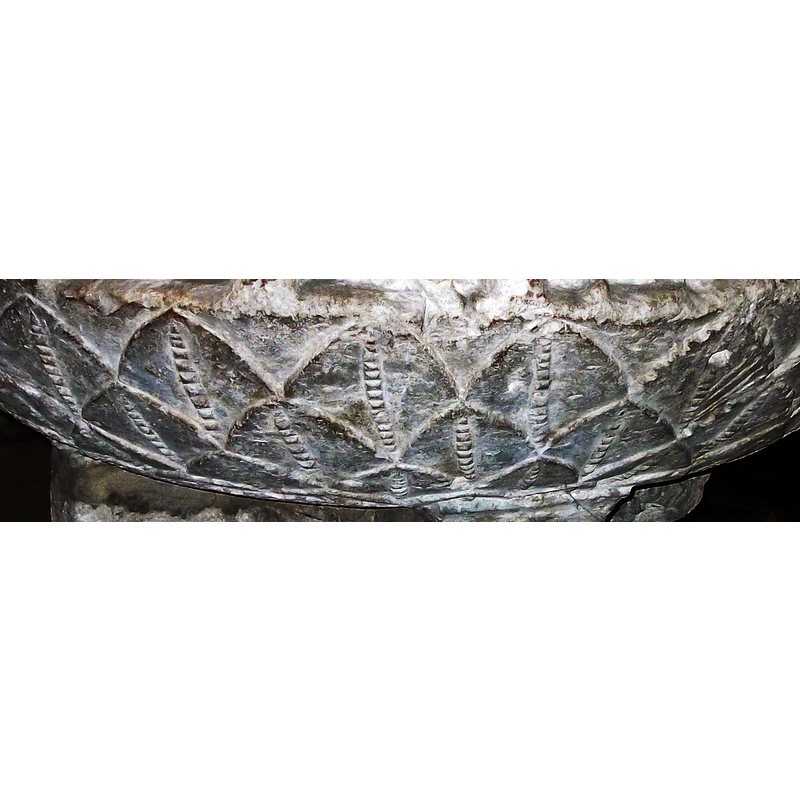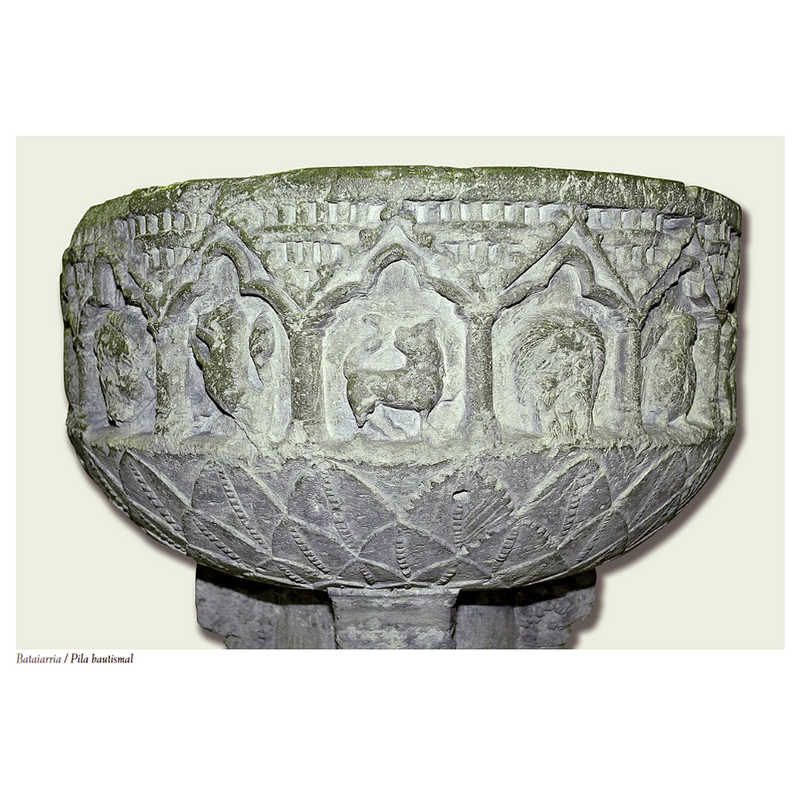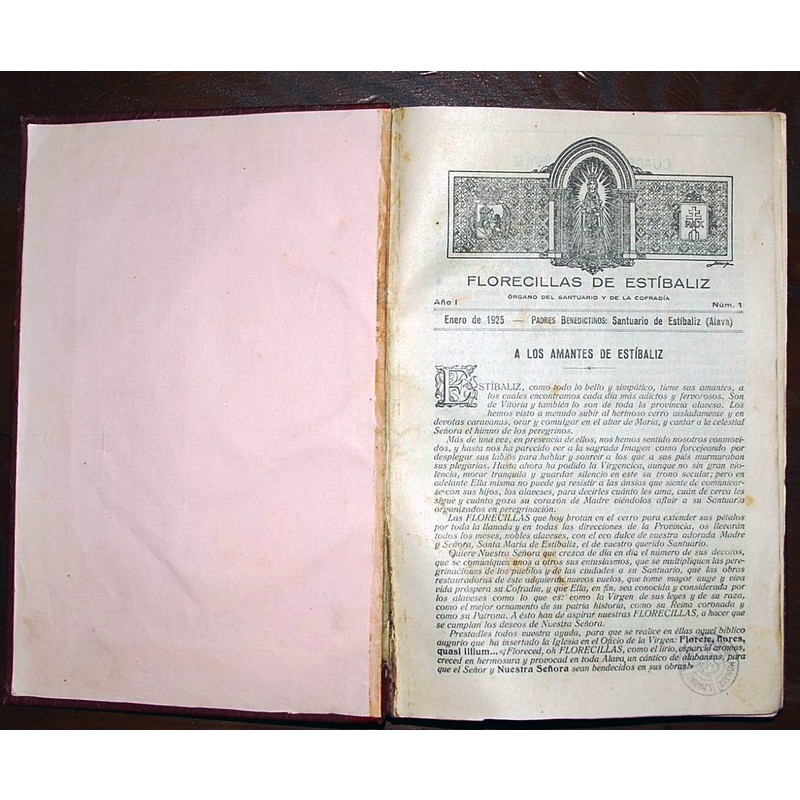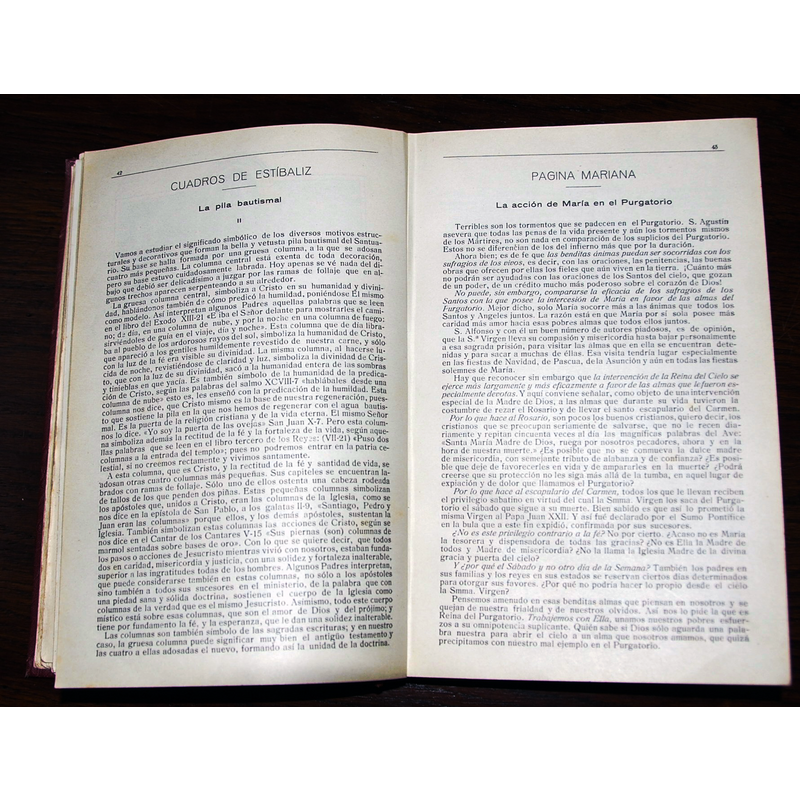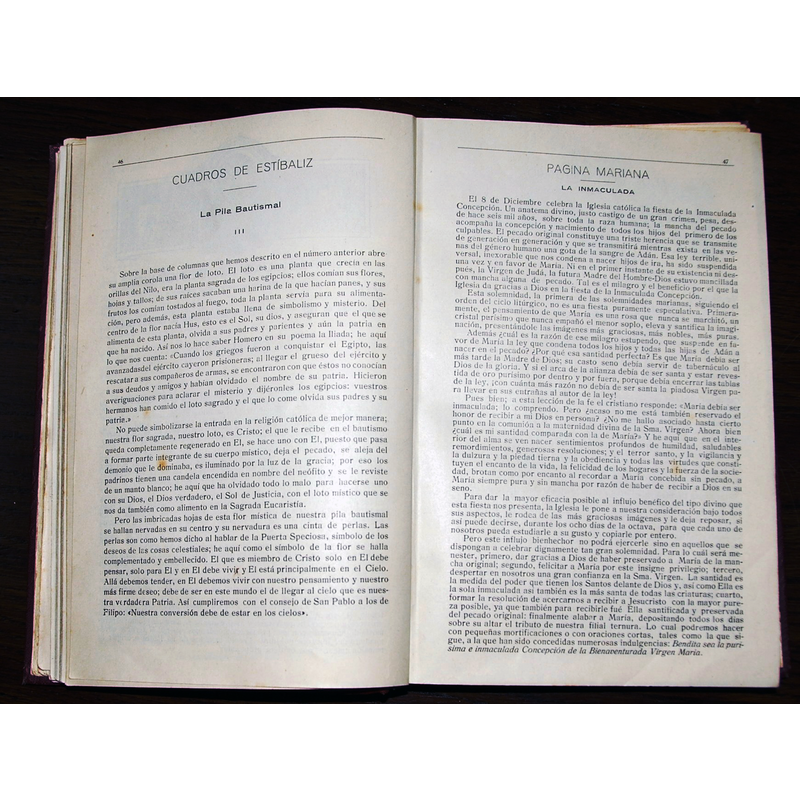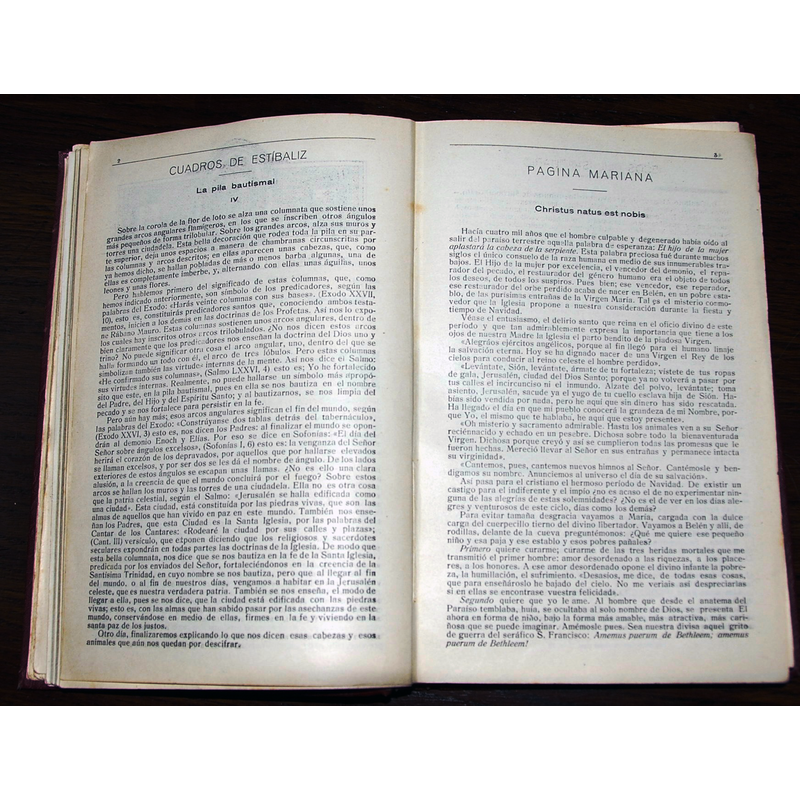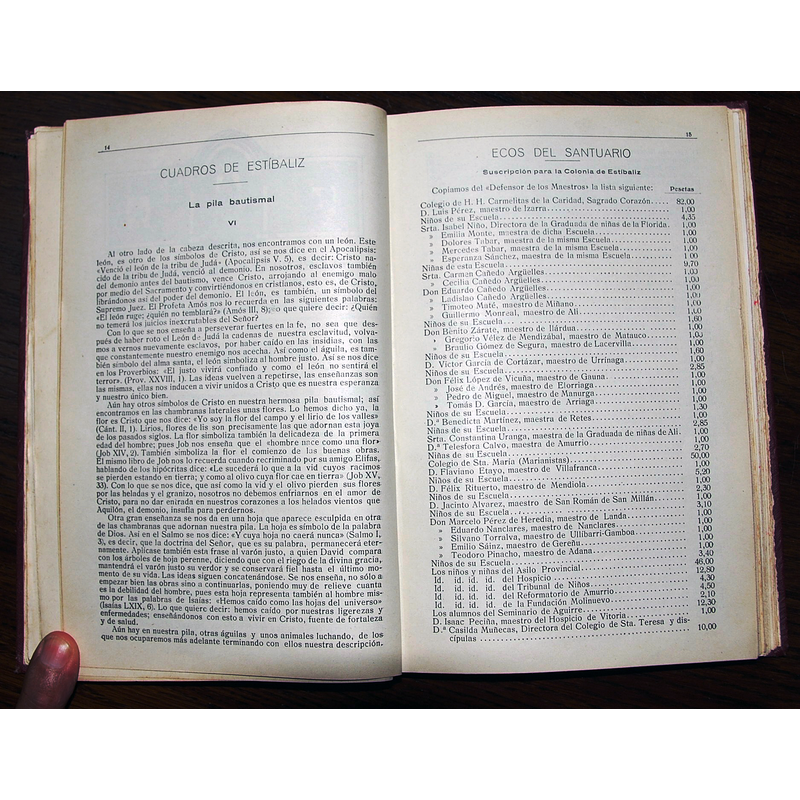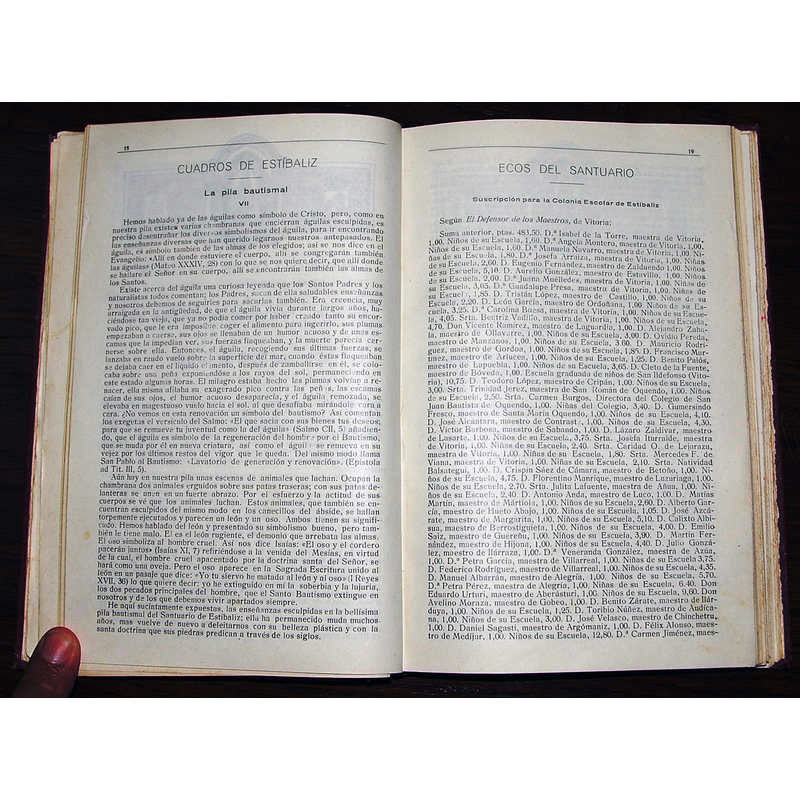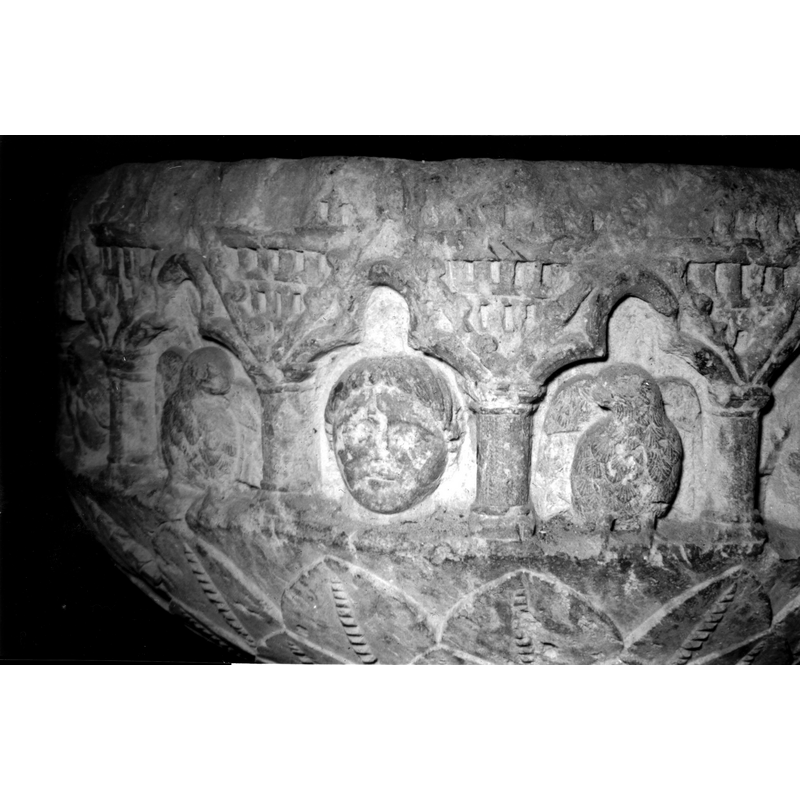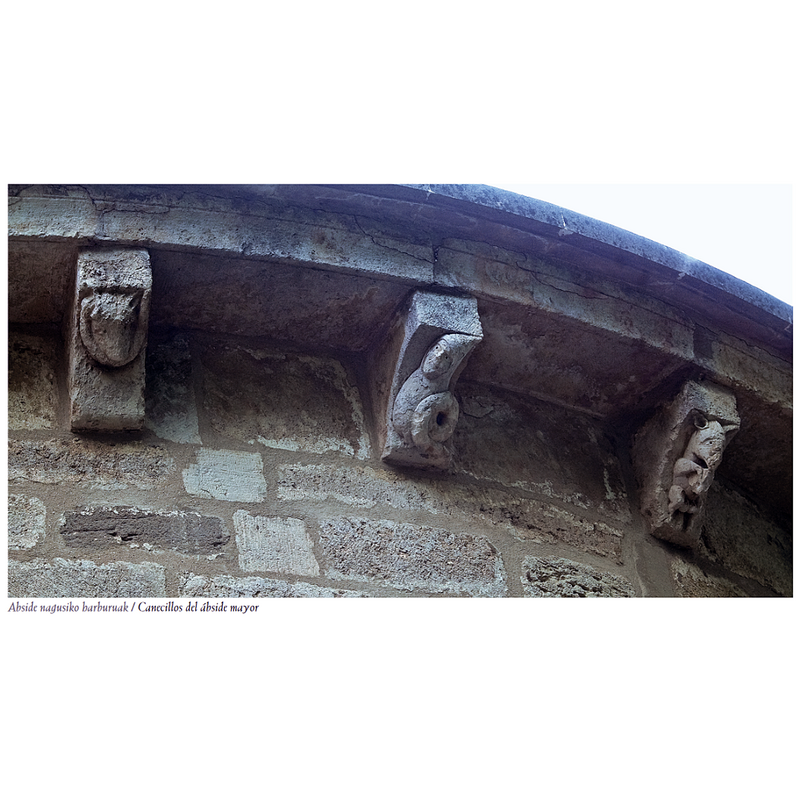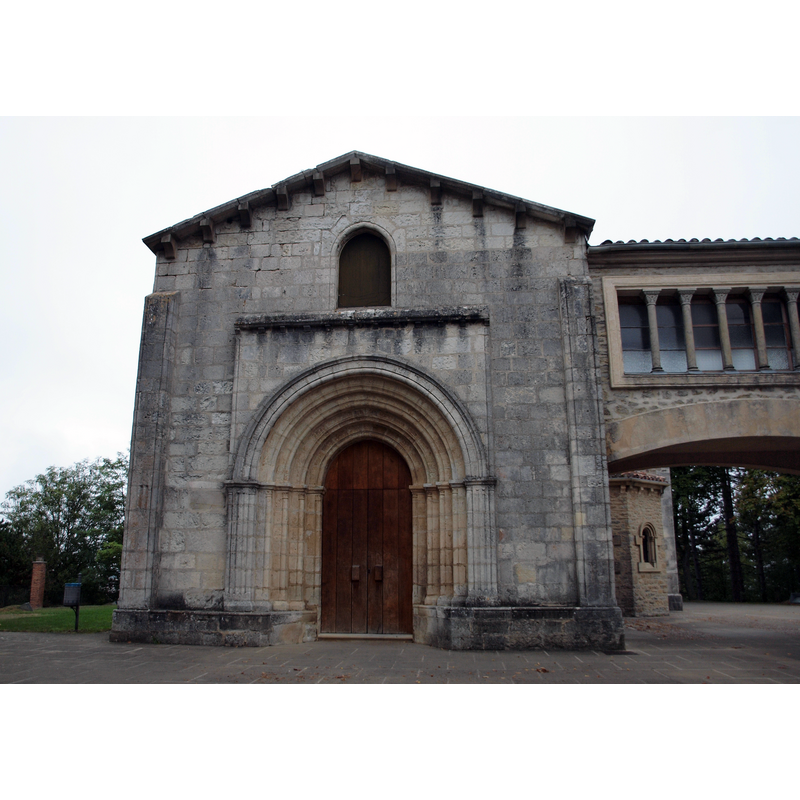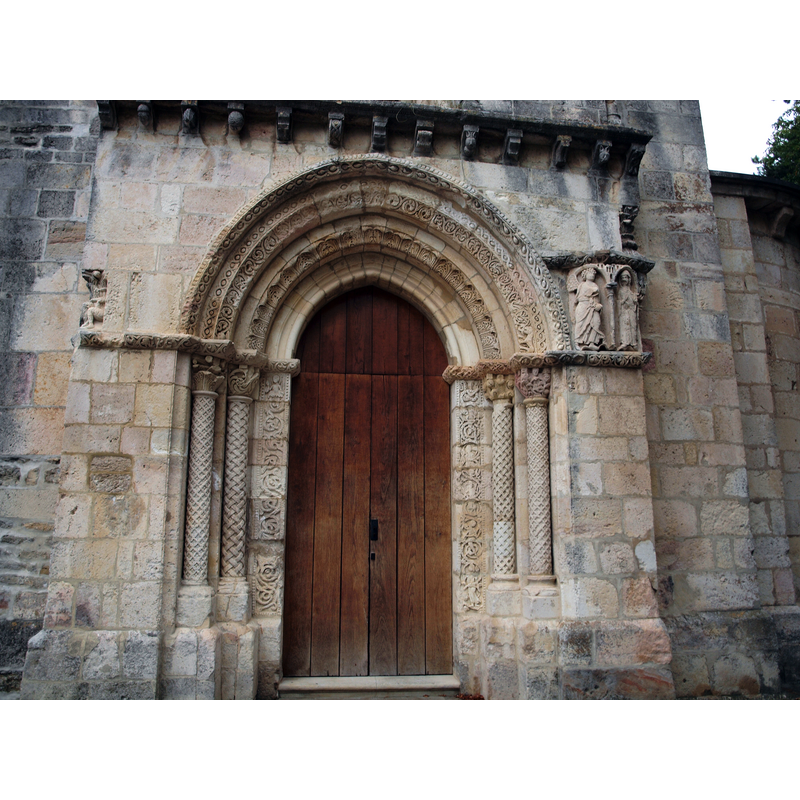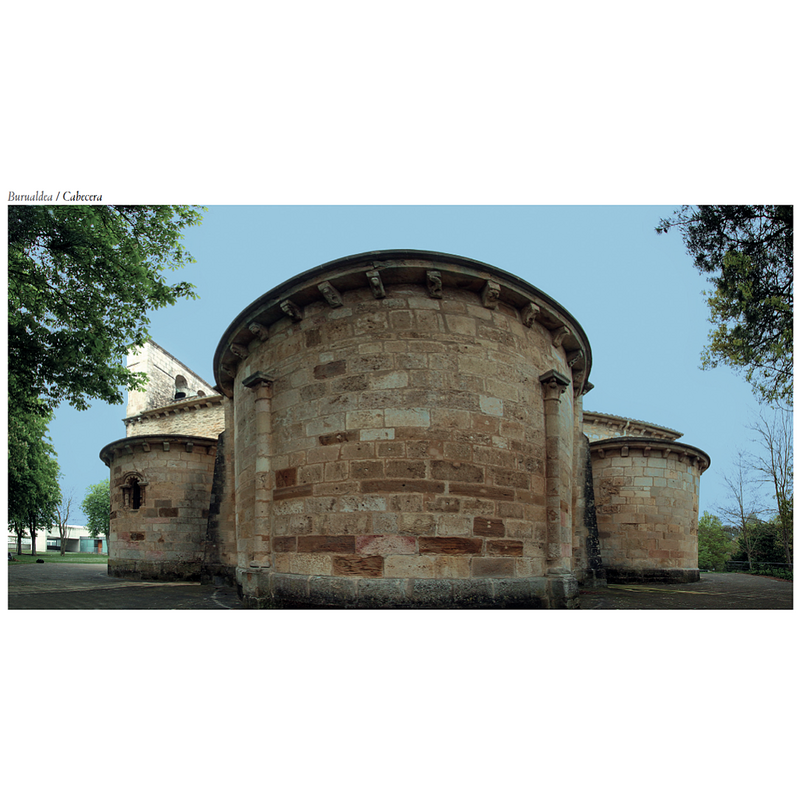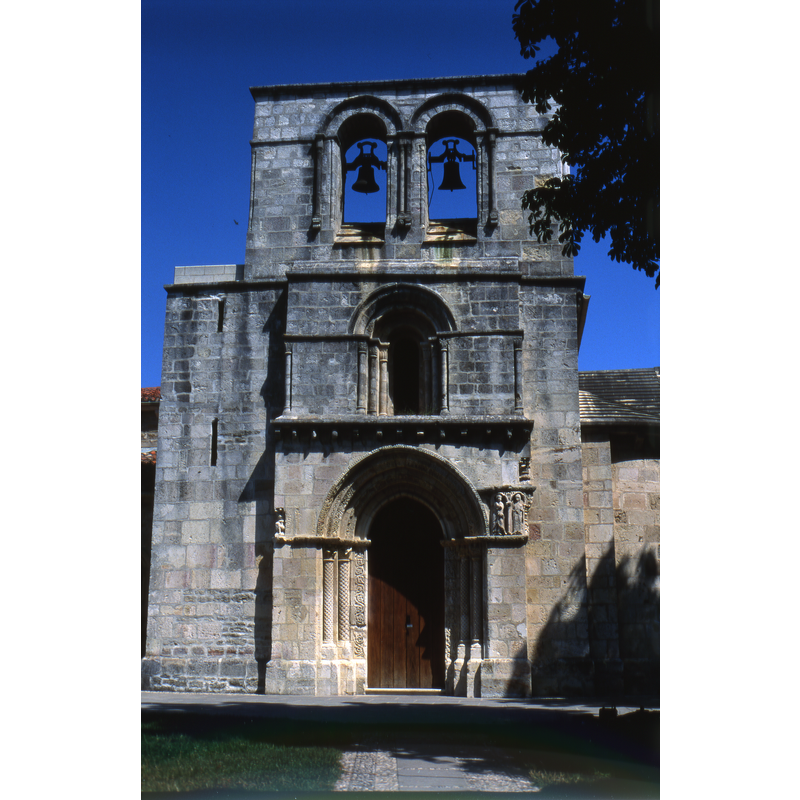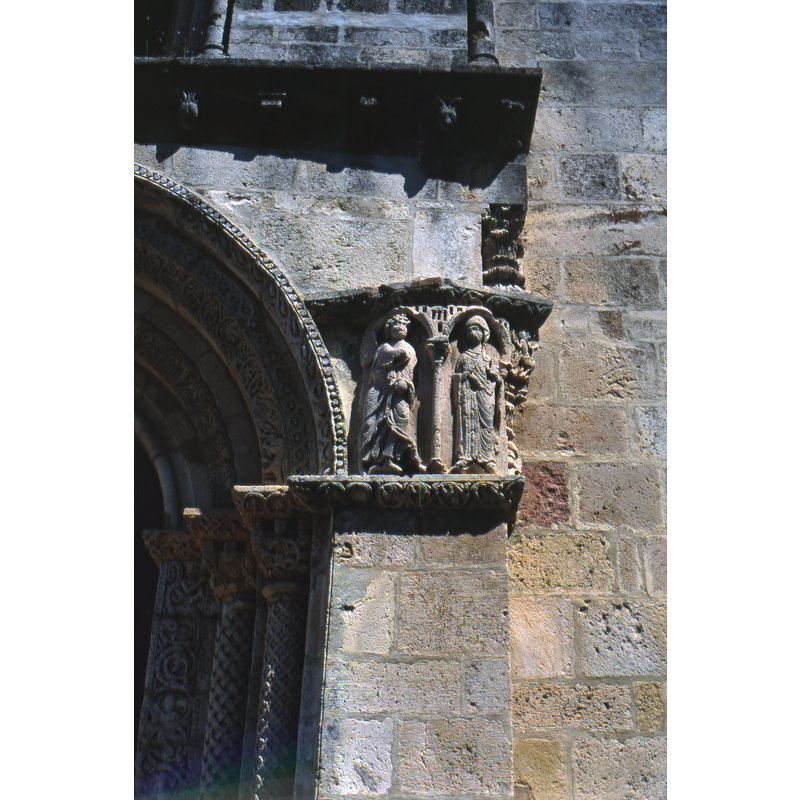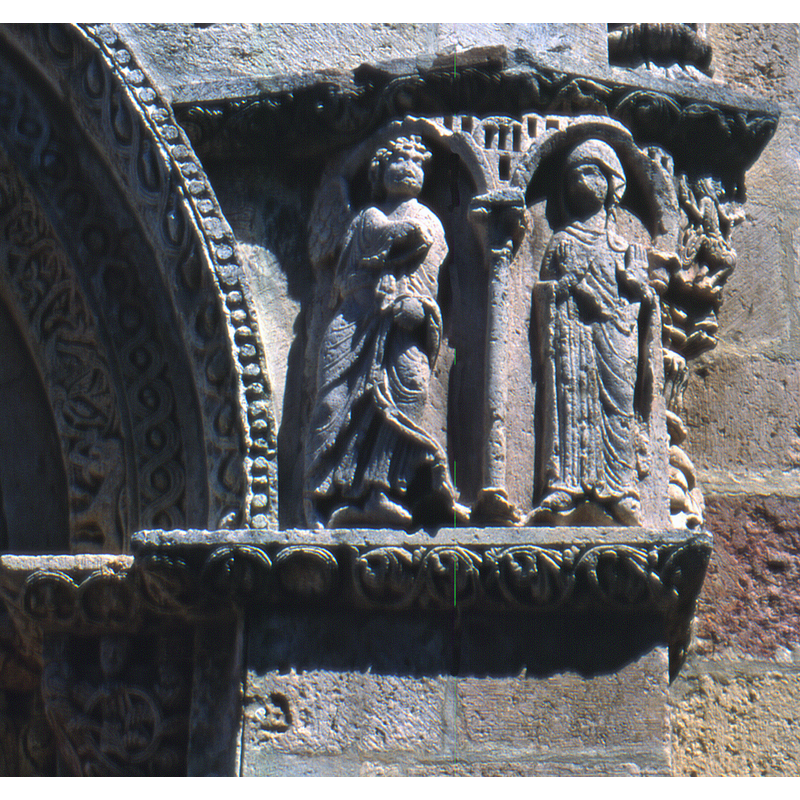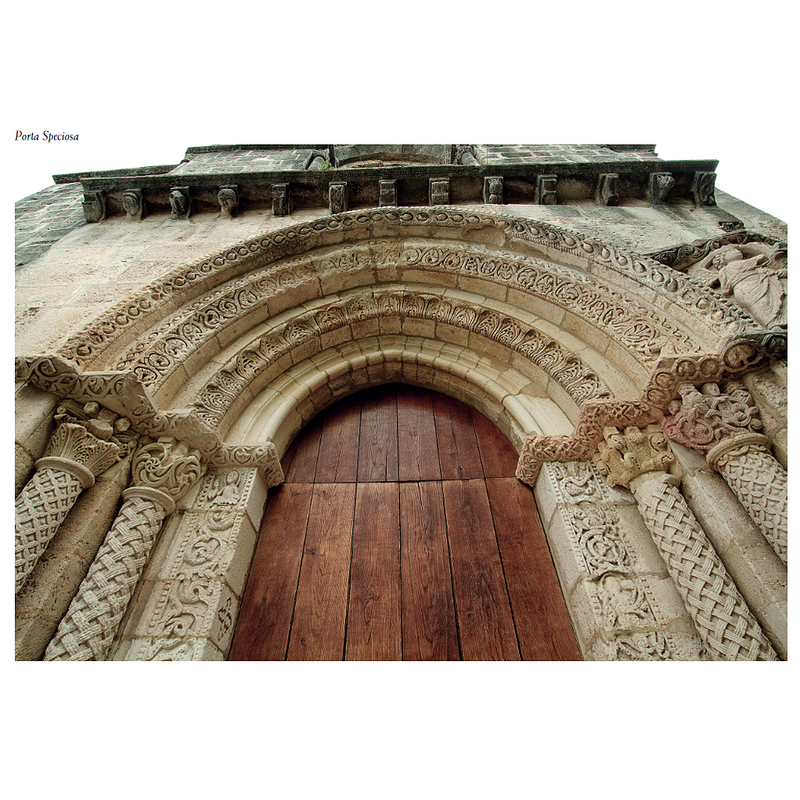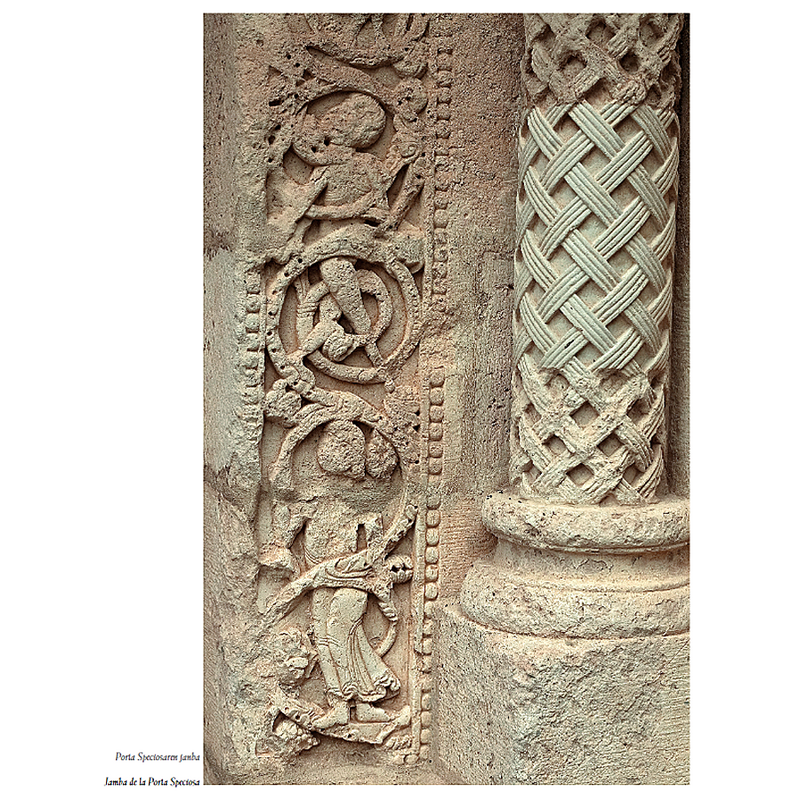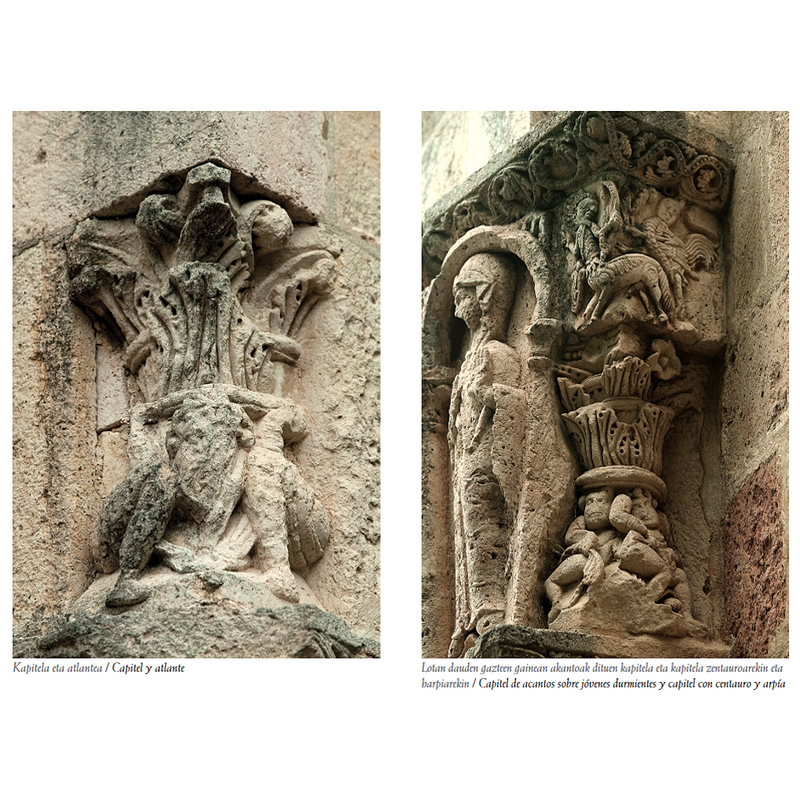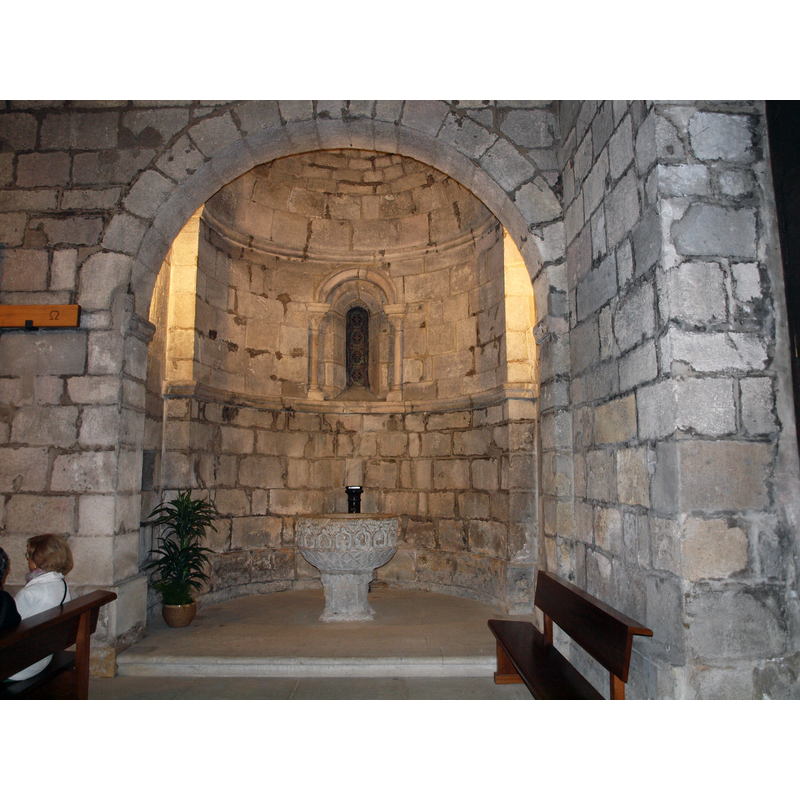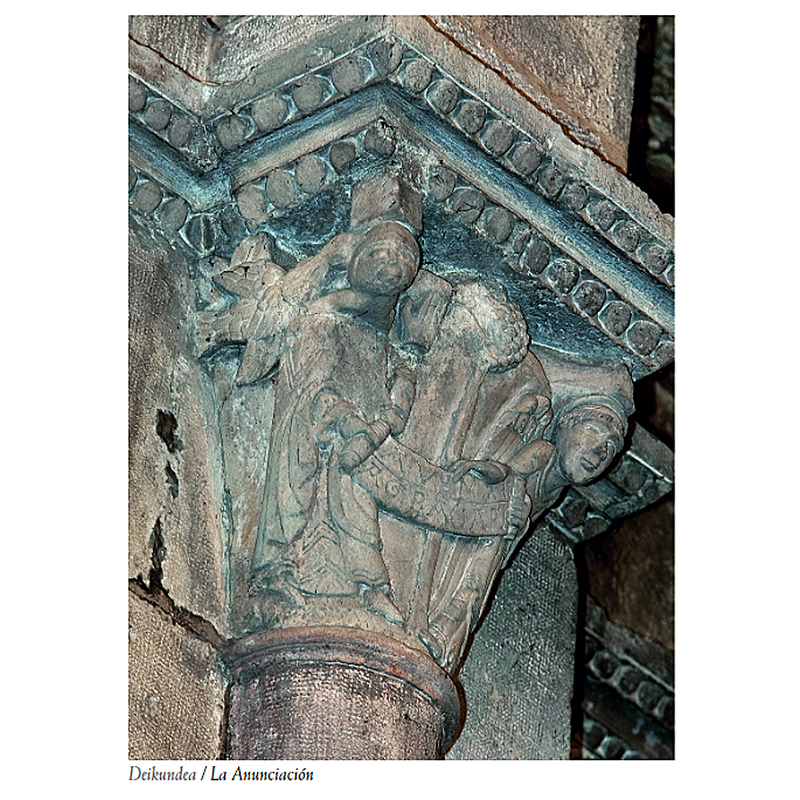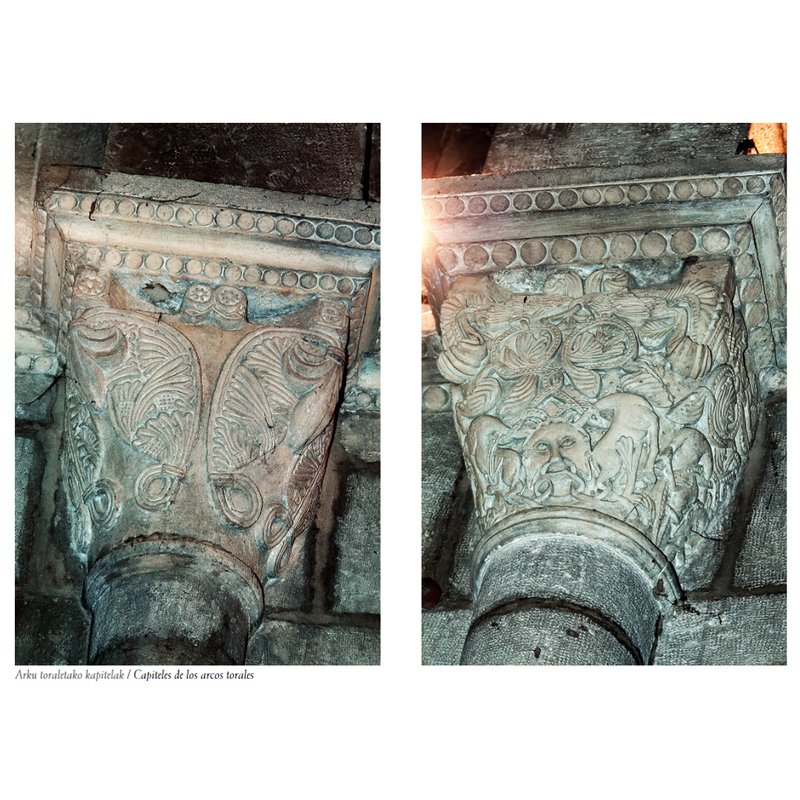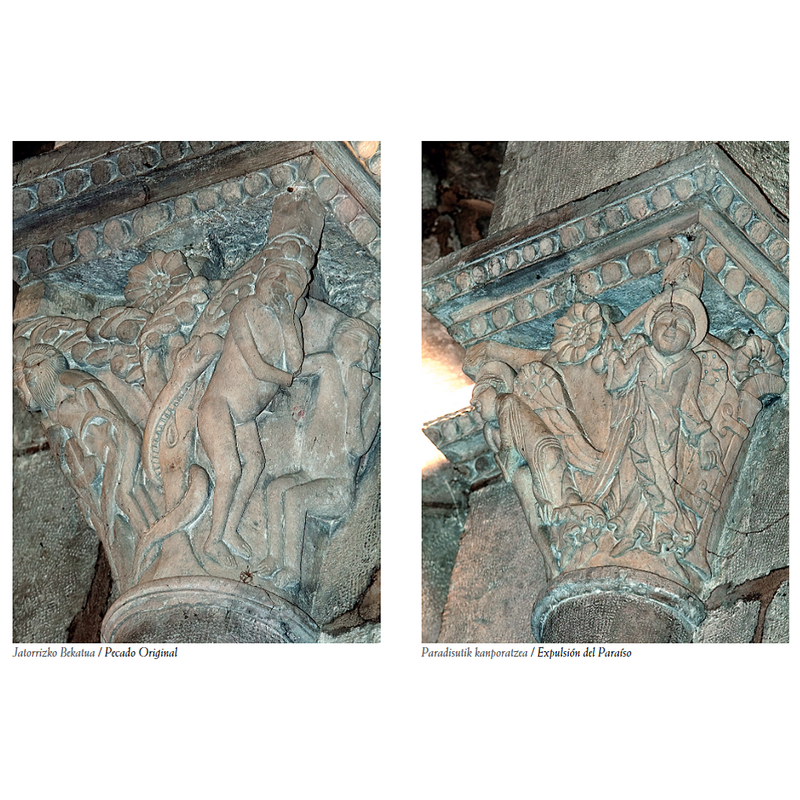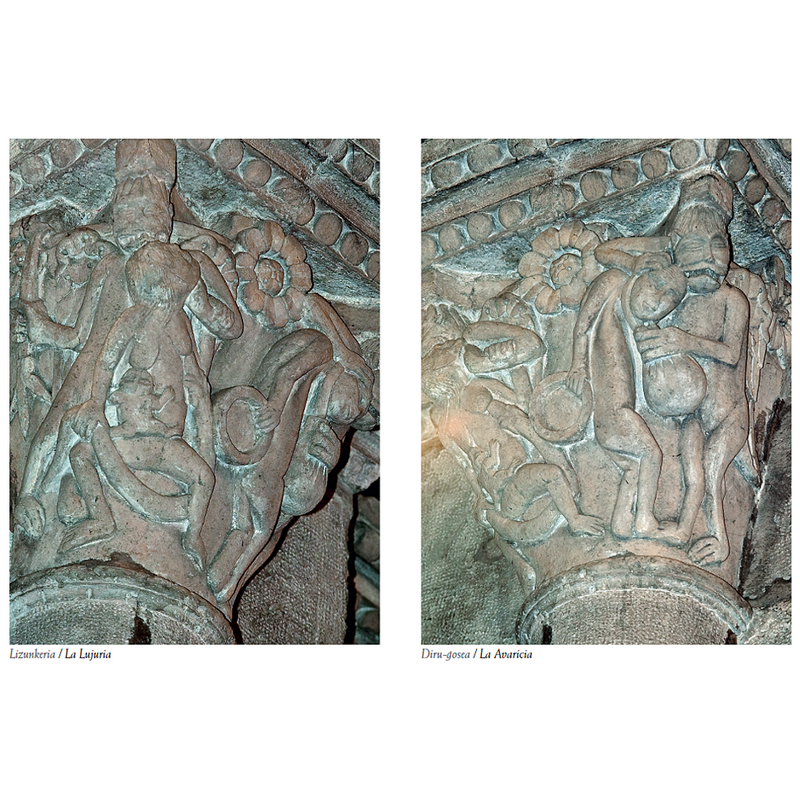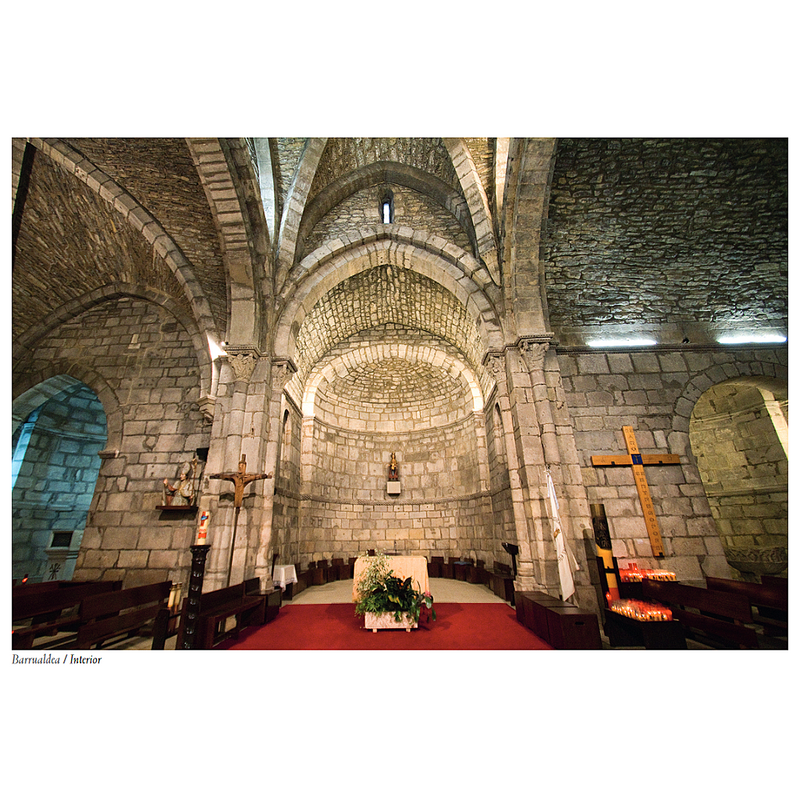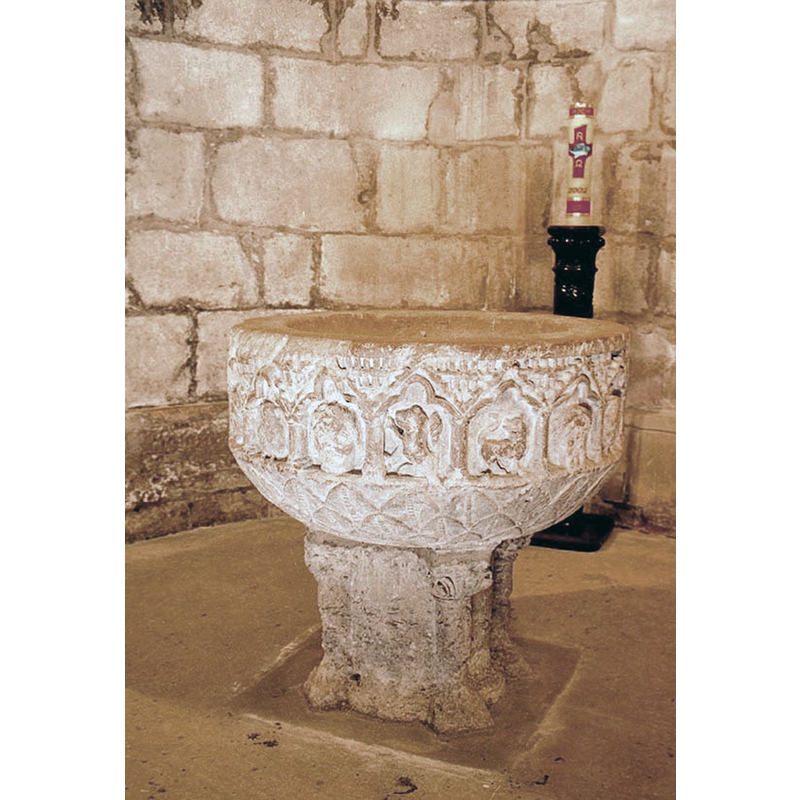Estibaliz / Estíbaliz / Estivaliz / Estivariz

Results: 46 records
Scene Description: Source caption: "Detalle de la copa de la pila bautismal; la parte inferior presenta decoración de hojas imbricadas y la superior arquería trebolada distintos motivos decorativos sin relación aparente: un cuadrúpedo que gira su cabeza hacia atrás, una cabeza barbada, un águila, dos leones enfrentados, etc."
Copyright Statement: Image copyright © Photo-Araba, 2024
Image Source: digital image [ES.01059.ATHA.GUE.CD. 08400] of an undated [1940-1960] B&W photograph by López de Guereñu [https://photo.araba.eus/s/photoaraba/item/60739] [accessed 3 August 2024]
Copyright Instructions: CC-BY-NC-SA 4.0
Apostle or saint - Evangelists - symbol - 4?
Scene Description: according to Pinedo (1930), two heads are visible, a man's and a lion's, forming the capitals of the angle colonnettes; two others, he adds, the eagle's and the ox', are missing
Copyright Statement: Image copyright © Baptisteria Sacra Index, 2024
Image Source: digital image of a photograph taken 13 August 1997
animal - mammal - lion - rampant
Scene Description: seen here on the left
Copyright Statement: Image copyright © Photo-Araba, 2024
Image Source: digital image [ES.01059.ATHA.GUE.CD. 08394] of an undated [1940-1960] B&W photograph by López de Guereñu [https://photo.araba.eus/s/photoaraba/item/60733] [accessed 3 August 2024]
Copyright Instructions: CC-BY-NC-SA 4.0
animal - mollusc - octopus
Scene Description: the identity of this motif is interpreted differently in some sources [cf. FontNotes]
Copyright Statement: Image copyright © Photo-Araba, 2024
Image Source: digital image [ES.01059.ATHA.GUE.CD. 08396] of an undated [1940-1960] B&W photograph by López de Guereñu [https://photo.araba.eus/s/photoaraba/item/60735] [accessed 3 August 2024]
Copyright Instructions: CC-BY-NC-SA 4.0
design element - architectural - arcade - trefoiled arches
design element - architectural - building?
Scene Description: the spandrels of the arcade are filled with a cribbing that resembles the representation of other buildings on fonts [e.g.: the font at Redecilla del Camino, in the nearby province of Burgos],, although some of them appear to be a design pattern
Copyright Statement: Image copyright © GFreihalter, 2010
Image Source: digital photograph taken 7 July 2010 by GFreihalter [http://commons.wikimedia.org/wiki/File:Est%C3%ADbaliz_Nuestra_Se%C3%B1ora_Taufbecken151.JPG]
Copyright Instructions: CC-BY-SA-3.0
design element - motifs - leaf
Scene Description: seen here to the right of the two facin animals -- identified as lotus in Pinedo (1930) [cf. FontNotes]
Copyright Statement: Image copyright © Photo-Araba, 2024
Image Source: digital image [ES.01059.ATHA.GUE.CD. 08395] of an undated [1940-1960] B&W photograph by López de Guereñu [https://photo.araba.eus/s/photoaraba/item/60734] [accessed 3 August 2024]
Copyright Instructions: CC-BY-NC-SA 4.0
design element - patterns - scalloped
Scene Description: patterned leaves arranged in a scalloped pattern all around the underbowl
Copyright Statement: Image copyright © Belen Guerrikabeitia, 2011
Image Source: detail of a digital photograph taken in 2011 by Belen Guerrikabeitia
Copyright Instructions: permission received via Mikel Unanue (e-mail of 7 April 2011)
human figure - male - head - bearded
Scene Description: seen here to the right of the lion
Copyright Statement: Image copyright © Fundación Santa María la Real, 2024
Image Source: digital image in the Enciclopedia del románico [https://www.romanicodigital.com/sites/default/files/pdfs/files/alava_ESTÍBALIZ.pdf] [accessed 3 August 2024]
Copyright Instructions: Standing permission received from the FSMLR
human figure - male - youth
information
information
information
information
information
information
information
information
view of basin
Copyright Statement: Image copyright © Fundación Santa María la Real, 2024
Image Source: digital image in the Enciclopedia del románico [https://www.romanicodigital.com/sites/default/files/pdfs/files/alava_ESTÍBALIZ.pdf] [accessed 3 August 2024]
Copyright Instructions: Standing permission received from the FSMLR
view of basin
Scene Description: Source caption: "Detalle de la copa de la pila bautismal; bajo una arquería presenta distintos motivos decorativos: dos leones enfrentados, una gran hoja plana"
Copyright Statement: Image copyright © Photo-Araba, 2024
Image Source: digital image [ES.01059.ATHA.GUE.CD. 08395] of an undated [1940-1960] B&W photograph by López de Guereñu [https://photo.araba.eus/s/photoaraba/item/60734] [accessed 3 August 2024]
Copyright Instructions: CC-BY-NC-SA 4.0
view of basin
Scene Description: Source caption: "Detalle de la copa de la pila bautismal; la parte inferior presenta decoración de hojas imbricadas y la superior arquería trebolada distintos motivos decorativos sin relación aparente. En este caso, dos águilas flanquean una cabeza de hombre imberbe"
Copyright Statement: Image copyright © Photo-Araba, 2024
Image Source: digital image [ES.01059.ATHA.GUE.CD. 08398] of an undated [1940-1960] B&W photograph by López de Guereñu [https://photo.araba.eus/s/photoaraba/item/60737] [accessed 3 August 2024]
Copyright Instructions: CC-BY-NC-SA 4.0
view of basin
Scene Description: Source caption: "Detalle de la copa de la pila bautismal; bajo una arquería presenta distintos motivos decorativos: un pulpo, una cabeza de hombre barbada, etc."
Copyright Statement: Image copyright © Photo-Araba, 2024
Image Source: digital image [ES.01059.ATHA.GUE.CD. 08396] of an undated [1940-1960] B&W photograph by López de Guereñu [https://photo.araba.eus/s/photoaraba/item/60735] [accessed 3 August 2024]
Copyright Instructions: CC-BY-NC-SA 4.0
view of basin
Scene Description: Source caption: "Detalle de la copa de la pila bautismal; la parte inferior presenta decoración de hojas imbricadas y la superior arquería trebolada distintos motivos decorativos sin relación aparente: rostros humanos, leones, un cuadrúpedo que mira hacia atrás, etc."
Copyright Statement: Image copyright © Photo-Araba, 2024
Image Source: digital image [ES.01059.ATHA.GUE.CD. 08394] of an undated [1940-1960] B&W photograph by López de Guereñu [https://photo.araba.eus/s/photoaraba/item/60733] [accessed 3 August 2024]
Copyright Instructions: CC-BY-NC-SA 4.0
view of church exterior
view of church exterior - apse - corbels
Copyright Statement: Image copyright © Fundación Santa María la Real, 2024
Image Source: digital image in the Enciclopedia del románico [https://www.romanicodigital.com/sites/default/files/pdfs/files/alava_ESTÍBALIZ.pdf] [accessed 3 August 2024]
Copyright Instructions: Standing permission received from the FSMLR
view of church exterior - detail
view of church exterior - detail
view of church exterior - east view
Copyright Statement: Image copyright © Fundación Santa María la Real, 2024
Image Source: digital image in the Enciclopedia del románico [https://www.romanicodigital.com/sites/default/files/pdfs/files/alava_ESTÍBALIZ.pdf] [accessed 3 August 2024]
Copyright Instructions: Standing permission received from the FSMLR
view of church exterior - south façade
view of church exterior - south façade - detail
view of church exterior - south façade - detail
view of church exterior - south portal - detail
Copyright Statement: Image copyright © Fundación Santa María la Real, 2024
Image Source: digital image in the Enciclopedia del románico [https://www.romanicodigital.com/sites/default/files/pdfs/files/alava_ESTÍBALIZ.pdf] [accessed 3 August 2024]
Copyright Instructions: Standing permission received from the FSMLR
view of church exterior - south portal - detail
Copyright Statement: Image copyright © Fundación Santa María la Real, 2024
Image Source: digital image in the Enciclopedia del románico [https://www.romanicodigital.com/sites/default/files/pdfs/files/alava_ESTÍBALIZ.pdf] [accessed 3 August 2024]
Copyright Instructions: Standing permission received from the FSMLR
view of church exterior - south portal - detail
Copyright Statement: Image copyright © Fundación Santa María la Real, 2024
Image Source: digital image in the Enciclopedia del románico [https://www.romanicodigital.com/sites/default/files/pdfs/files/alava_ESTÍBALIZ.pdf] [accessed 3 August 2024]
Copyright Instructions: Standing permission received from the FSMLR
view of church exterior - south view - window - detail
Copyright Statement: Image copyright © Fundación Santa María la Real, 2024
Image Source: digital image in the Enciclopedia del románico [https://www.romanicodigital.com/sites/default/files/pdfs/files/alava_ESTÍBALIZ.pdf] [accessed 3 August 2024]
Copyright Instructions: Standing permission received from the FSMLR
view of church interior - baptistery
view of church interior - chancel arch - capital
Copyright Statement: Image copyright © Fundación Santa María la Real, 2024
Image Source: digital image in the Enciclopedia del románico [https://www.romanicodigital.com/sites/default/files/pdfs/files/alava_ESTÍBALIZ.pdf] [accessed 3 August 2024]
Copyright Instructions: Standing permission received from the FSMLR
view of church interior - chancel arch - capital - 2
Copyright Statement: Image copyright © Fundación Santa María la Real, 2024
Image Source: digital image in the Enciclopedia del románico [https://www.romanicodigital.com/sites/default/files/pdfs/files/alava_ESTÍBALIZ.pdf] [accessed 3 August 2024]
Copyright Instructions: Standing permission received from the FSMLR
view of church interior - chancel arch - capital - 2
Copyright Statement: Image copyright © Fundación Santa María la Real, 2024
Image Source: digital image in the Enciclopedia del románico [https://www.romanicodigital.com/sites/default/files/pdfs/files/alava_ESTÍBALIZ.pdf] [accessed 3 August 2024]
Copyright Instructions: Standing permission received from the FSMLR
view of church interior - chancel arch - capital - 2
Copyright Statement: Image copyright © Fundación Santa María la Real, 2024
Image Source: digital image in the Enciclopedia del románico [https://www.romanicodigital.com/sites/default/files/pdfs/files/alava_ESTÍBALIZ.pdf] [accessed 3 August 2024]
Copyright Instructions: Standing permission received from the FSMLR
view of church interior - looking east
Copyright Statement: Image copyright © Fundación Santa María la Real, 2024
Image Source: digital image in the Enciclopedia del románico [https://www.romanicodigital.com/sites/default/files/pdfs/files/alava_ESTÍBALIZ.pdf] [accessed 3 August 2024]
Copyright Instructions: Standing permission received from the FSMLR
INFORMATION
FontID: 00115BAS
Object Type: Baptismal Font1
Church/Chapel: Santuario de Nuestra Señora de Estibaliz / Estibalizko santutegi / Andre Maria eliza
Church Patron Saints: St. Mary the Virgin
Church Location: Estibaliz Entitatea, 1, 01193 Villafranca, Alava / Araba, Spain -- Tel.: +34 639 31 07 79 / +34 660 76 63 83
Country Name: Spain
Location: Alava / Araba, País Vasco / Euskadi
Directions to Site: Located off (S) the A-3110, 2 km NE of Argandoña, 10 km E of Vitoria / Gasteiz, and in its municipality
Ecclesiastic Region: Diócesis de Vitoria
Font Location in Church: In the small apse to the S of the central apse
Century and Period: 13th century, Early Gothic
Credit and Acknowledgements: We are grateful to Belen Guerrikabeitia, David de la Garma Ramírez, Mikel Unanue and Juan Antonio Olañeta for their photographs of this font. We are also grateful to the Fundación Santa María la Real [www.romanicodigital.com] for their permission to reproduce content from the Enciclopedia del románico
Church Notes: the monastery, originally of the 10thC, is documented by 1074 but the present church dates from the 12th and 13th century; much modified since
Font Notes:
Click to view
Described and illustrated in Castro (1915: 150 and pl.32) as a beautiful example of a much later date than the church itself which dates to the 11th century or earlier. Various motifs in trefoil arches encircle the bowl - symbolic, without an obvious narrative intent [cf. Pinedo's and Bilbao's views below]. Described and illustrated in Pinedo (1930: 185-199), who gives a detailed commentary on, and interpretation of, the specific symbolism of the different motifs found on this font in relation to biblical themes (ibid., p. 185-199). Pinedo argued that the colonnettes of the base had the symbols of the four Evangelists as capitals; although most of the ornamentation of the base had disappeared by his time [ca. 1930], he did identify the head of a lion and that of a man. The font is listed with multiple illustrations in López de Guereñu [https://photo.araba.eus/s/photoaraba/item/60739] [accessed 2 August 2024]: "Pila bautismal del santuario de Nuestra Señora de Estibaliz en Argandoña. pila bautismal del siglo XIII. La copa de la pila descansa sobre un pedestal formado por un núcleo redondeado al que se adosan cuatro columnas con capiteles decorados; la parte inferior de la copa presenta decoración de hojas imbricadas y la superior se organiza mediante una arquería trebolada que alberga distintos motivos decorativos sin orden aparente". Described and illustrated in López de Ocáriz (1997: 165ff and ills. 89, 90), according to whom the font was located earlier in a chapel of the north side, and later was transferred to the absidiole on the south side; he dates the font to the same period as the capitals of the north transept, to ca. 1300 or a little later. Described and illustrated in Bilbao (1994: 87-92, 116 and fig. 50-53) who identifies the figures in the arches as "the whole range of living creatures: humans, quadrupeds, birds, vegetal life and, as representation of the creatures of the seas, the octopode jellyfish" [our translation], "used here not as casual motifs as a very precise symbol [...] the octopode jellyfish being the animal symbol equivalent to the eight-p`re las aguas"]. Bilbao (ibid.) proceeds to identify, after the 1)jellyfish; 2)human head, bearded; 3)eagle with spread wings; 4)human head (a baby's); 5)eagle with spread wings; 6)human head wearing short mane; 7)rampant lion; 8)passant lion; 9)human head, bearded and long mane; 10)eagle with spread wings; 11)two engaged quadrupeds, possibly lions in fight; 12) leaf motif. Bilbao (ibid.), citing Reutersvärd's work on the Paradise fonts, opposes Pinedo's identification of the lotus on the leaves of the underbowl and proposes instead the palmette and the imbricated leaf as symbols related to the Tree of Life. Noted in Plazaola Artola (2008?). Described and illustrated in the entry for this church in the Enciclopedia del románico [https://www.romanicodigital.com/sites/default/files/pdfs/files/alava_ESTÍBALIZ.pdf] [accessed 3 August 2024]: ""La pila bautismal, al menos presente desde el siglo xiii, recuerda su función como parroquia [...] En el absidiolo meridional –antes ocupaba el del lado opuesto– se halla una pila bautismal del siglo xiii, de ejecución, por tanto, posterior al conjunto de la iglesia. Un sector del lado posterior de la taza quedó sin tallar, evidenciando que se dispuso adosada o muy próxima al muro, quizá en el absidiolo del norte. No responden al mismo estilo la taza y el pie, y es de lamentar que su base esté muy deteriorada. El pie responde a una fórmula, habitual en la Llanada alavesa, que reúne cuatro columnillas en torno a un cilindro, pero en Estíbaliz encaja a duras penas en la base de la taza, interfiriendo en ella y rasgando su decoración de hojas. De los pequeños capiteles vegetales, sólo uno muestra con claridad un rostro humano estereotipado, enmarcado por tallos de los que penden frutos. Corresponden a la misma factura tardía de los capiteles del soporte del brazo septentrional del crucero. En cambio, las tallas de la copa resultan más expresivas y variadas, combinando en toda la base curva de la taza una gran flor abierta, con finas arquerías trilobuladas,
y en el remate, una triple hilera de ajedrezado que imita castilletes. Resulta muy original la enorme corola de al menos cuatro hileras de pétalos imbricados. Recuerda una gran flor acuática, como la del nenúfar –en Occidente–, o del loto –en Oriente–. Las hojas se disponen planas, apuntadas y con marcada nervadura en cuadradillo, y sólo tres de la fila superior presentan el borde entallado. En la banda ancha de la taza se dispone una galería de arquerías trilobuladas, dobladas por gabletes silueteados por crochet, sobre columnillas. Se completaron doce arquerías que engloban figuras talladas que, en sentido contrario a las agujas del reloj, se identifican como: Aqua; rostro masculino con cabello ceñido y perilla; águila ex-
playada; cabeza de joven imberbe con pelo rizado; águila explayada; cabeza deteriorada de joven; león rampante; león pasante; rostro masculino con densa cabellera y barba; águila explayada; dos leones erguidos afrontados; hoja acuática de limbo ancho ondulado. la única figura difícil
de reconocer es la primera, y por ello su visión ha sido forzada en los estudios, según la previa interpretación iconológica, presentándola como una cara humana o como un cefalópodo o medusa octópoda. Esta figura tiene el aspecto de una bolsa combada, abierta hacia abajo y con cinco ramificaciones colgantes. Se puede reconocer ahí un antiguo símbolo del Abyssus –véase la miniatura del fol. 5 v de la biblia de Ripoll, del siglo xi (Roma, Vaticano, bib. apost. lat. 5729, fol. 5v) y otras–. Pero en concreto la mejor correspondencia la ofrece una miniatura de la Clavis Physicae de Honorio de Autun –que sigue el Periphyseon de escoto–, pintada hacia mediados del siglo xii (París, b.N. ms lat 6734, fol 3v). Allí, entre las cuatro naturalezas de la Creación, Ignis, Aer, Aqua, Terra, (Fuego, aire, agua y tierra), la identificación del Aqua es exactamente igual que la de la pila de Estíbaliz, sólo que en las ramificaciones colgantes aparecen peces el paralelismo con la miniatura permite avanzar en la interpretación de las figuraciones de la pila. Como allí, el Aer se relaciona con aves (águilas); la Terra tanto con plantas (la hoja abierta), con animales terrestres (leones), como humanos (las cuatro cabezas). Respecto al Ignis, se ven nubes y figuras con nimbo: serán santos. en conclusión, de las doce figuras de la pila de Estíbaliz, la primera significa Aqua, muy lógico en ambiente bautismal; las águilas –fig. 3, 5 y 10– son el Aer; y el resto, tanto leones como cabe-
zas humanas –de jóvenes o viejos–, se refieren a la Terra. Queda sin alusión el Ignis. Respecto a las arquerías treboladas y los castilletes, se combinan habitualmente en los doseles del gótico, ya iniciado el siglo xiii, quizá perdiendo gradualmente la típica evocación de la Jerusalén Celestial, que aún seguía claramente vigente en Armentia."
COORDINATES
Church Latitude & Longitude Decimal: 42.848219, -2.570028
Church Latitude & Longitude DMS: 42° 50′ 53.59″ N, 2° 34′ 12.1″ W
MEDIUM AND MEASUREMENTS
Material: stone (?)
Number of Pieces: two
Font Shape: cylindrical (mounted)
Basin Interior Shape: round
Basin Exterior Shape: round
Drainage Notes: no lining
Rim Thickness: 15-16 cm*
Diameter (inside rim): 71-72 cm*
Diameter (includes rim): 102 cm*
Height of Basin Side: 31-32 cm*
Basin Total Height: 54 cm*
Height of Base: 48 cm*
Font Height (less Plinth): 102 cm*
Notes on Measurements: * BSI
REFERENCES
Catálogo Monumental de la Diócesis de Vitoria, 1968
Arriola Loyola, Juan Luis, Trayecto alavés: de Oyón a Etxandio, [Vitoria]: Diputación Foral de Alava, Dpto. de Cultura y Euskera; Caja Laboral Popular, 1996
Bilbao López, Garbiñe, Iconografía de las pilas bautismales del románico castellano: Burgos y Palencia, Burgos: Editorial La Olmeda, S.L., 1996
Bilbao López, Garbiñe, Simbolismo e Iconografía Bautismal en el Arte medieval Alavés, 1994
Castro, Cristóbal de, Catálogo monumental de España: Provincia de Alava, Madrid: Est. Tip. Sucesores de Rivadeneyra, 1915
Fundación Santa María la Real, Enciclopedia del románico, Fundación Santa María la Real, 2020+. Accessed: 2024-08-03 00:00:00. URL: www.romanicodigital.com.
Gómez Gómez, Agustín, "Programa iconográfico de la pila bautismal: manifestación de la iconografía oriental en el románico alavés", 1983, Estíbaliz, 1983, pp. 14-18; p. 14-18
López de Ocáriz, José Javier, Pays Basque roman: Alava, Biscaye, Guipúzcoa, La Pierre-qui-vire, Yonne: Zodiaque, 1997
Pinedo, Ramiro de, Simbolismo en la escultura medieval española, Madrid: Espasa-Calpe, 1930
Plazaola Artola, Juan, "El arte gótico en Euskal Herria", hiru.com [Etengabeko Ikaskuntza], [2008?]
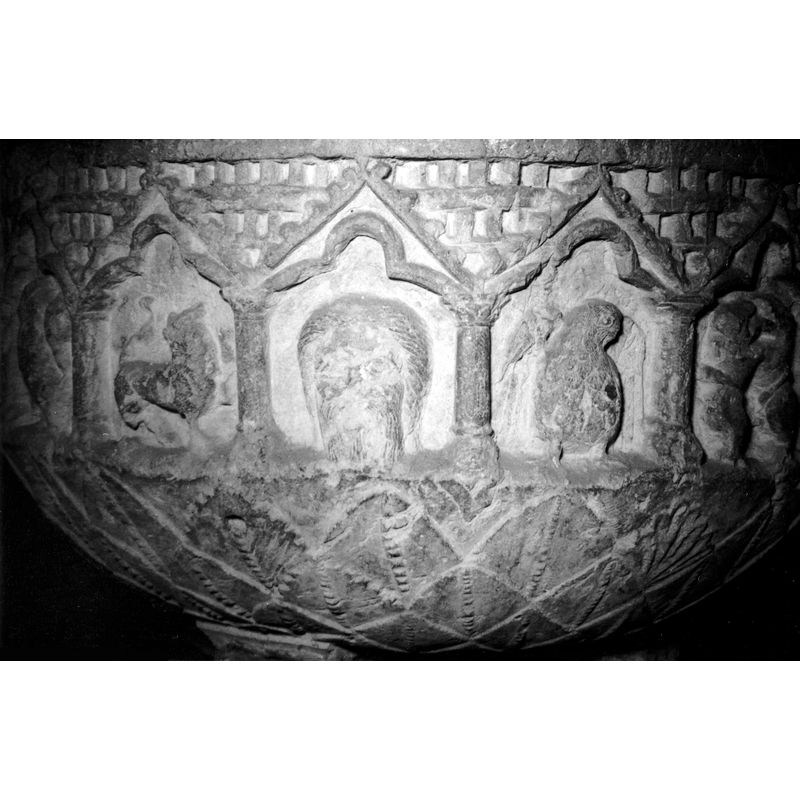


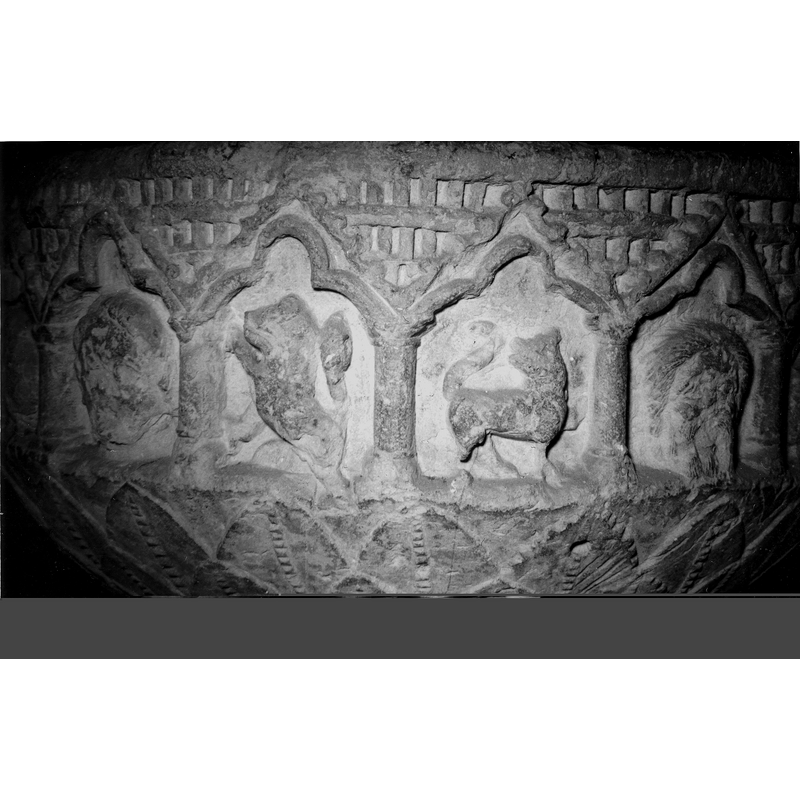
![the identity of this motif is interpreted differently in some sources [cf. FontNotes]](/static-50478a99ec6f36a15d6234548c59f63da52304e5/compressed/1240803016_compressed.png)
![the spandrels of the arcade are filled with a cribbing that resembles the representation of other buildings on fonts [e.g.: the font at Redecilla del Camino, in the nearby province of Burgos],, although some of them appear to be a design pattern](/static-50478a99ec6f36a15d6234548c59f63da52304e5/compressed/1110409005_compressed.png)
![seen here to the right of the two facin animals -- identified as lotus in Pinedo (1930) [cf. FontNotes]](/static-50478a99ec6f36a15d6234548c59f63da52304e5/compressed/1240803014_compressed.png)
